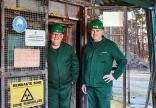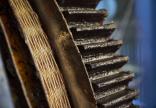Goodbye to the hoisting system of shaft 1
The hoisting system that had been in use until early 2020 dates from the 50s, when it was used at the Ressaix coal mine. Once activities at the mine had ceased, the hoisting system was transferred to Mol in the early eighties. The former drilling company Foraky had begun excavating a shaft to a depth of over 225m in the Boom Clay Layer there, as commissioned by SCK CEN. SCK CEN was determined to build a laboratory in this clay layer, in order to investigate whether this layer would be suitable for deep disposal of radioactive waste. The laboratory was accessed through a lift cage – the term in the mining world is a “cage” – that was lowered to a depth of 225m on a steel cable. A ladder served as the emergency exit and the technicians working at HADES had to climb up to the top at least once a year to show that they were fit enough to get to the surface on their own, should the hoisting system fail to function.
After an initial period of research during the 80s, the expansion of HADES began in the late nineties. A second access shaft was mandatory for this. It is this second shaft with a larger lift cage that has mainly been used to descend underground since the year 2000. However, the first shaft will remain important and necessary as an evacuation route. An overview of the construction of HADES can be found here.










